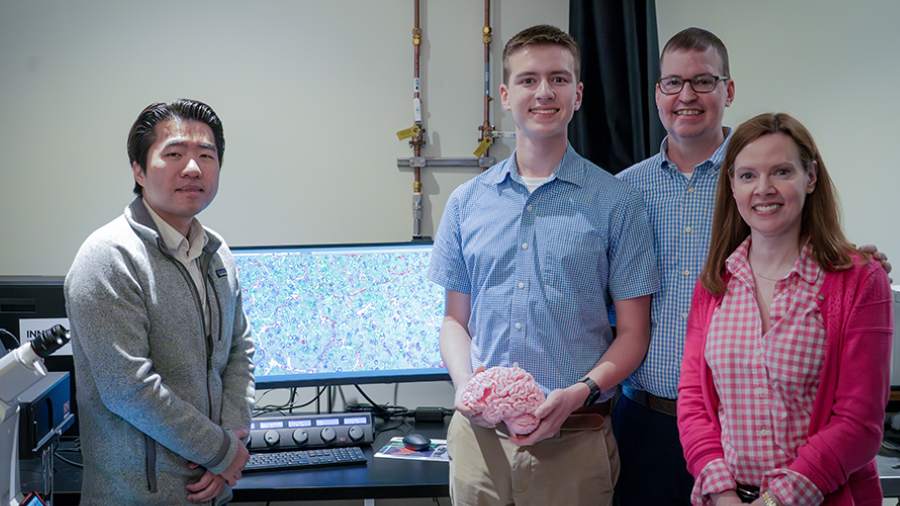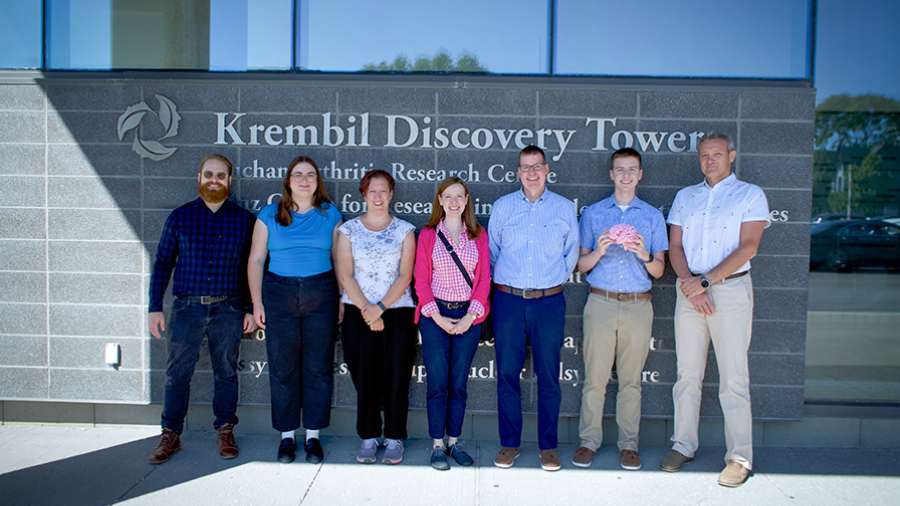
Sawyer Thompson, 18, arrives at UHN’s Krembil Research Institute on a sunny summer morning, smiling, his doting parents in tow and carrying a 3D printed brain.
The family has travelled from Washington, D.C. to meet the team behind the World Community Grid, a network of volunteers who donate their unused computing power to advance scientific research. IBM started the World Community Grid in 2004; it moved to UHN’s Krembil Research Institute in 2021.
“As long as I can remember, I’ve always been interested in how things work,” Sawyer says. “When I was two, I remember going into parking lots and looking at cars, trying to figure out how they’re built.
“And then as I grew up, I kind of fell in love with technology.”
At age eight, Sawyer built his first computer, a “cool experience” he remembers, which led to him founding his first company — building and selling computers on eBay. A few years later, at 11, he also started a cryptomining company.
During the pandemic, Sawyer 3D printed and donated face shields for health care workers. He also built a website and Twitter bot to help the public find and secure available COVID-19 vaccination appointments.
“Well, I’m proud, of course — super proud,” says Sawyer’s dad Brett, grinning at his son.
“This was all Sawyer following his passion, his curiosity. Then he realized that he could use technology for good, and find solutions to big problems. It turned into a kind of ‘jumping off’ point for him.”
Using technology for good also became a way for then 12-year-old Sawyer to process an unexpected family situation, after Brett was diagnosed with brain cancer.
“I just wanted to help my dad,” Sawyer recalls. “I had no money to donate, no knowledge about how to cure cancer. I felt powerless.”
Exceeded the original goal in two months
Googling “how to cure cancer,” Sawyer learned about the World Community Grid, and about how someone with no scientific expertise, at no cost, and with minimal time commitment, can actually help to power research by donating unused computer power.
He started small, using his own computers in his basement. Then, he recruited his grandparents to help.
“I realized how user-friendly the World Community Grid is after I instructed my grandparents over the phone on how to set it up,” Sawyer jokes.
From there, he set up a World Community Grid volunteer team called Sawyer’s Cancer Fighting Network and got to work, supporting the Mapping Cancer Markers project. His original goal was to gather enough computing power to save 100 years of cancer research processing time in one year, by his father’s next birthday.
“It seemed like impossible, but thanks to the amazing global community on World Community Grid, we were able to exceed that goal within two months!” Sawyer says proudly.
In the four years since, Sawyer’s team has grown to more than 200 volunteers, and he has far surpassed his goal, collecting enough computer power for 1,800 years of cancer research processing time.
“It feels amazing to be able to help people with cancer, and advance cancer research too,” Sawyer says, glancing over at his dad with a smile.

Sawyer and his parents decided to travel to Toronto to meet the scientists at UHN’s Krembil Research Institute who run the World Community Grid, and see first-hand how their efforts are furthering research.
“I’m always humbled when I meet World Community Grid volunteers, who are so passionate about the project,” says Dr. Igor Jurisica, Senior Scientist at UHN’s Krembil Research Institute and a professor at the University of Toronto. “I actually had goosebumps meeting the Thompsons today and hearing more about their story, because it reminds us of the impact our research can have.
“As scientists, we often worry if we will be able to finish a computation related to a research project in our lifetime, there is simply so much data to go through and analyze. That’s why World Community Grid volunteers are so important.”
Sawyer and his parents were given a personal tour of UHN’s Krembil Research Institute, a purpose-built research tower housing more than 200 scientists focused on arthritis, brain and vision research.
At the Advanced Optical Microscopy Facility (AOMF) where scientists use highly advanced imaging equipment for their experiments, the Thompsons peered through high-powered microscopes, seeing brain cells up close.
“We are so grateful to be able to see the research in action and meet the team personally,” says Sawyer’s mother, Susan. “Now, he’ll be able to take this experience back to his high school, to his friends, to our community, and it’s helped to ignite his passion for technology and to do good in the world.”
“As a mom, what more could you want for your child?”
It’s ‘awesome’ getting to see science up close
The 3D printed brain Sawyer carries with him to Krembil was a Father’s Day gift for his father, made from an MRI image of Brett’s brain, after his brain cancer diagnosis. It’s missing a part just above the right ear, where Brett’s tumour was resected six years ago.
“I loved it,” says Brett. “We have a lot of ‘tumour humour’ in our home, it helps us process all of the emotions around my diagnosis.”
Sawyer enjoyed showing the Krembil research staff his dad’s 3D printed brain and reminding them why their work is so important.
“Research is what powers new discoveries, and we need them more than ever,” says Brett.
“Being here today is awesome, just getting to see the science up close and meet the people who come to work every day trying to make a difference,” adds Sawyer. “I’m grateful for the experience.”
As for what he’ll do next, Sawyer is keeping his options open.
“I see myself continuing to use technology for good. I don’t know exactly how yet, but definitely continuing our work with the World Community Grid,” he says. “I feel like the real power of technology isn’t, like, speed or whatever, it’s how you use it to make a positive impact in the world.”

No one ever changed the world on their own but when the bright minds at UHN work together with donors we can redefine the world of health care together.


